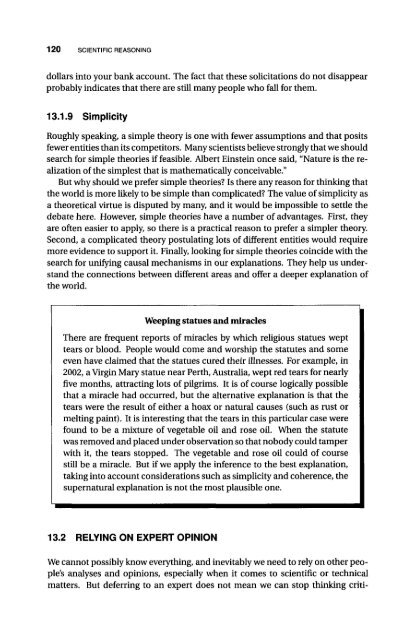An Introduction to Critical Thinking and Creativity - always yours
An Introduction to Critical Thinking and Creativity - always yours
An Introduction to Critical Thinking and Creativity - always yours
Create successful ePaper yourself
Turn your PDF publications into a flip-book with our unique Google optimized e-Paper software.
120 SCIENTIFIC REASONING<br />
dollars in<strong>to</strong> your bank account. The fact that these solicitations do not disappear<br />
probably indicates that there are still many people who fall for them.<br />
13.1.9 Simplicity<br />
Roughly speaking, a simple theory is one with fewer assumptions <strong>and</strong> that posits<br />
fewer entities than its competi<strong>to</strong>rs. Many scientists believe strongly that we should<br />
search for simple theories if feasible. Albert Einstein once said, "Nature is the realization<br />
of the simplest that is mathematically conceivable."<br />
But why should we prefer simple theories? Is there any reason for thinking that<br />
the world is more likely <strong>to</strong> be simple than complicated? The value of simplicity as<br />
a theoretical virtue is disputed by many, <strong>and</strong> it would be impossible <strong>to</strong> settle the<br />
debate here. However, simple theories have a number of advantages. First, they<br />
are often easier <strong>to</strong> apply, so there is a practical reason <strong>to</strong> prefer a simpler theory.<br />
Second, a complicated theory postulating lots of different entities would require<br />
more evidence <strong>to</strong> support it. Finally, looking for simple theories coincide with the<br />
search for unifying causal mechanisms in our explanations. They help us underst<strong>and</strong><br />
the connections between different areas <strong>and</strong> offer a deeper explanation of<br />
the world.<br />
Weeping statues <strong>and</strong> miracles<br />
There are frequent reports of miracles by which religious statues wept<br />
tears or blood. People would come <strong>and</strong> worship the statutes <strong>and</strong> some<br />
even have claimed that the statues cured their illnesses. For example, in<br />
2002, a Virgin Mary statue near Perth, Australia, wept red tears for nearly<br />
five months, attracting lots of pilgrims. It is of course logically possible<br />
that a miracle had occurred, but the alternative explanation is that the<br />
tears were the result of either a hoax or natural causes (such as rust or<br />
melting paint). It is interesting that the tears in this particular case were<br />
found <strong>to</strong> be a mixture of vegetable oil <strong>and</strong> rose oil. When the statute<br />
was removed <strong>and</strong> placed under observation so that nobody could tamper<br />
with it, the tears s<strong>to</strong>pped. The vegetable <strong>and</strong> rose oil could of course<br />
still be a miracle. But if we apply the inference <strong>to</strong> the best explanation,<br />
taking in<strong>to</strong> account considerations such as simplicity <strong>and</strong> coherence, the<br />
supernatural explanation is not the most plausible one.<br />
13.2 RELYING ON EXPERT OPINION<br />
We cannot possibly know everything, <strong>and</strong> inevitably we need <strong>to</strong> rely on other people's<br />
analyses <strong>and</strong> opinions, especially when it comes <strong>to</strong> scientific or technical<br />
matters. But deferring <strong>to</strong> an expert does not mean we can s<strong>to</strong>p thinking criti-
















